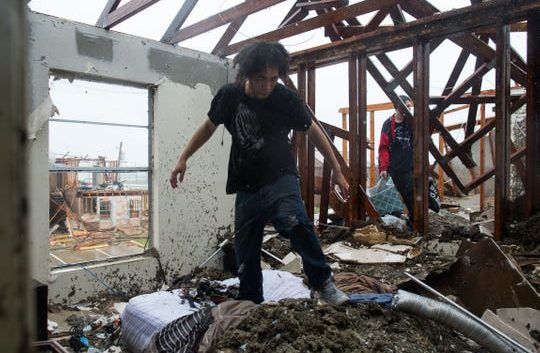- Carolina Hurricanes Star Jaccob Slavin delights Raleigh kids with back-to-school bash
- Hillsborough charter school relocates after Eno River flooding, community rallies in support
- Southport reflects on Hurricane Isaias five years later
- Texas bills increasing youth camp safety face long odds, even after Hill Country floods
- Kerr County officials failed to follow certain aspects of disaster plan during Texas floods
NOAA: Don't be fooled by 'near-normal' hurricane predictions for South Texas

Rockport celebrated how far they have come since Hurricane Harvey devastated the area a year ago on Aug. 25, 2017. Alexandria Rodriguez, Corpus Christi Caller-Times
June 1 typically marks the start of hurricane season. Residents living on the storm-prone Texas coast shouldn’t get caught off guard by any “normal” predictions.
The National Oceanic and Atmospheric Administration predicts a near-normal 2019 Atlantic hurricane season, which ends Nov. 30.
“We don’t want people to be distracted by predictions,” said John Metz, Warning Coordination Meteorologist for the National Weather Service in Corpus Christi. “We don’t want people to let down their guard in any way, and we want people to take precaution and treat this like any hurricane season.”
This year, 12 named storms, including six hurricanes and three major hurricanes, are predicted for the Atlantic Ocean.
“The prediction is missing the most important part — we can’t predict where the storms are going to form or where they are going to hit,” Metz said.
Last year was above normal for storm activity with 15 storms, eight hurricanes and two major hurricanes. It also was well above normal and the costliest season on record with 17 storms, 10 hurricanes and six major hurricanes.
Three of the hurricanes struck the U.S. coast.
More: Hurricane Hub: Your guide on how to prepare
2017 HURRICANE COSTS
Storms in the Atlantic for the 2017 season resulted in nearly $300 billion in damages, Metz said. Hurricane Harvey caused more than 717,000 claims with $19 billion in insured-property losses. The storm flooded about 250,000 vehicles with auto-insured losses of $3.5 billion, according to the Insurance Council of Texas.
Overall, insured-flood losses from Hurricane Harvey totaled about $10 billion, but the losses suffered from uninsured homeowners may have topped $100 billion.
STAY INSURED
The Insurance Council of Texas urges residents to review their homeowner and auto insurance protection, update their evacuation plans and make an inventory of their property.
“You cannot purchase a windstorm policy once a named storm is in the (Gulf of Mexico) and a flood insurance policy takes effect 30 days after purchase,” Mark Hanna, the insurance council’s spokesperson said in a news release.
Usually, general homeowners’ insurance policies do not provide flood protection, even from a hurricane. The council encourages anyone living near the Texas coast to consider it, even if they aren’t required to purchase flood insurance.
SEASON OUTLOOK DETAILS
The NOAA outlook forecasts a 40-percent chance of a near-normal hurricane season, a 30 percent chance of an above-normal season and a 30 percent chance of a below-normal season.
The ongoing El Niño — an irregular series of climatic changes affecting the equatorial Pacific region and farther — is expected to continue and subdue the intensity of the hurricane season, according to the NOAA.
Countering El Niño is the expected combination of warmer-than-average sea-surface temperatures in the tropical Atlantic Ocean and Caribbean Sea, and an enhanced west African monsoon.
Both conditions favor increased hurricane activity.
“It doesn’t matter what these predictions are, we need to take preparedness in the same way,” Metz said.
TIPS TO PREPARE FROM FEMA
- Get insured. Talk to your insurance agent or contact the National Flood Insurance Program at 800-427-4661. Learn more about flood insurance at www.fema.gov/NFIP. For information on homeowners, wind and hail insurance, visit https://go.usa.gov/xQ7px.
- Get your stuff together. Create an emergency kit including water, food and medications for at least three days as well as some cash, a first aid kit, flashlight and batteries. For tips on building an emergency kit visit https://go.usa.gov/xmX9v. You should also bring any important documents you may need in a disaster. For more on safeguarding your documents, visit https://go.usa.gov/xm5yR.
- Get your route ready. Map out evacuation routes in multiple directions and establish meeting points with your family. Also figure out where you’ll shelter if you don’t have time to evacuate. Learn more at www.ready.gov/evacuating-yourself-and-your-family.
- Get the FEMA app. The FEMA application, available at www.fema.gov/mobile-app, sends out National Weather Service alerts, safety reminders, emergency checklists and information about shelters.
- Get alerts. Find out if your community uses a text or email emergency-notification system, and sign up. You can also get alerts through the National Oceanic and Atmospheric Association’s Weather Radio (www.nws.noaa.gov/nwr) and www.hurricanes.gov. You may also consider picking up an emergency radio, which receives alerts and can be charged by solar power or hand crank.
Kathryn Cargo follows business openings and developments while reporting on impacts of the city government’s decisions. Help support local journalism with a digital subscription to the Caller-Times.
RELATED COVERAGE
Thank you! You’re almost signed up for
Keep an eye out for an email to confirm your newsletter registration.
More: Here’s how to watch out for storms during hurricane season
More: Here’s what you need in your ultimate hurricane preparedness list
More: Gov. Abbott: Hurricane Harvey recovery provides road map to survival for future disasters
Read or Share this story: https://www.caller.com/story/news/local/2019/05/31/noaa-dont-fooled-near-normal-2019-south-texas-hurricane-predictions/1287655001/